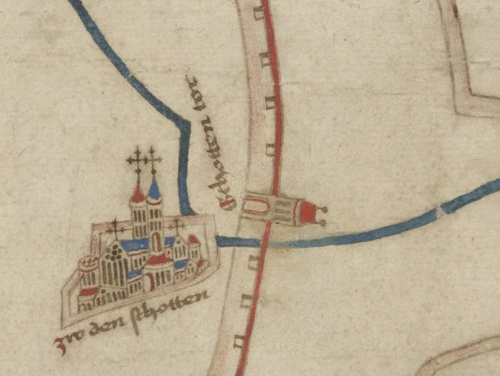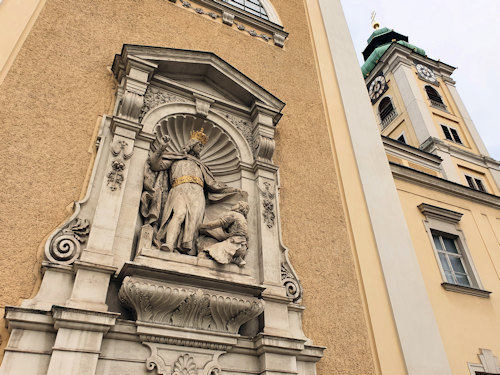
Back in the day, Heinrich II. Jasomirgott founded the Schottenstift abbey just outside the Vienna city walls. His medieval-sounding name offers a clue as to the age of the complex: the abbey church (the Schottenkirche) celebrated its 800th birthday a few years ago.
- Consecrated in 1200 (some of this original church still remains)
- Most of what you see is 17th-century baroque architecture
- Limited access for visitors (entrance area only)
- Book a classical concert* in a church or palais
- See also:
The Schottenstift abbey church

(The view from the Freyung squre)
Names can be deceptive. Take the Schottenkirche, for example. The word-for-word English translation is Church of the Scots, which suggests an origin somewhere north of Hadrian’s wall.
Actually, Irish monks founded the wider Schottenstift abbey that houses the church, arriving at the invitation of the first Duke of Austria (our Heinrich II. Jasomirgott) way back in the 12th century. The complex passed into the care of the Benedictines in the early 15th century.
The apparent confusion disappears when you take a closer look at the history of the term, “Scot” (and who doesn’t want to do that?) In earlier centuries, the word applied to various Gaelic peoples, notably those from Ireland.

(Palais Harrach and the Schottenkirche around 1725; drawn by Salomon Kleiner, engraved by Johann August Corvinus and published by Johann Andreas d. Ä. Pfeffel; Wien Museum Inv.-Nr. 105765/48; excerpt reproduced with permission under the terms of the CC0 licence)
The abbey grounds include a museum, grammar school, guesthouse, apartments, a shop, offices, library, and more. The composer, Gustav Mahler, used to stay there with family on visits to Vienna. The Café Diglas coffee house is one of my favourite cafés.
And, of course, the abbey also has its rather fine church.
The original Romanesque church on this site enjoyed its consecration in 1200. Meanwhile, over in Mongolia, a fellow named Temüjin Borjigin had yet to assume the title of Genghis Khan. That’s the kind of age we’re dealing with here.

(Part of the Albertinian map from sometime after 1460 (based on a document from 1421/22) showing the Schottenstift abbey and church near Vienna’s original outer wall; Wien Museum Inv.-Nr. 31018; excerpt reproduced with permission under the terms of the CC0 licence)
Little remains of the original building, though you can see remnants in the Romanesque chapel found separately off to one side of the church.
What we see today is largely a Baroque creation consecrated in 1648, with subsequent renovations and restorations (particularly in the early and late 19th century).
Inside reflects the opulent decoration associated with that architectural era, with the gorgeous ceiling scrollwork a standout for me.

(The front entrance)
The church’s crypt actually provides a last resting place for two of Vienna’s most famous “sons”:
- The very same Heinrich II. Jasomirgott (1112 – 1177) who founded the abbey. A statue of the duke also graces the outer wall that faces the Freyung square
- Count Ernst Rüdiger Starhemberg (1630-1701), who led the defences against the Ottomans during the legendary 1683 siege of Vienna

(Memorial outside to Heinrich II. Jasomirgott)
The Freyung square in front of the church hosts a weekly organic farmers market most of the year, as well as popular Easter and Christmas markets.
Those seasonal markets enjoy a particularly good reputation as a source of decorations.
Head across that square from the Schottenkirche towards the city centre for another ecclesiastical joy: the Am Hof square includes the Kirche am Hof, a Gothic 14th century church with a towering 17th century front.
How to get to the Schottenkirche
See directions for the neighbouring Schottenstift abbey museum. The museum contains numerous artworks and artifacts collected by the monks over the years, including some rather famous altar panels from the 15th century.
Enter the church through its west entrance directly on the Freyung square without needing to go into the abbey complex. The entrance to the chapel with the Romanesque elements is just beyond the opposite end of the church at Freyung 6A.
Address: Freyung 6, 1010 Vienna | Website (for the abbey)